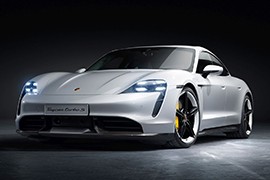PORSCHE Taycan Turbo Models/Series Timeline, Specifications & Photos
First production year: 2019
Engines: Electric
Porsche added the Turbo GT version to the Taycan lineup in March 2023, giving customers a track-ready electric vehicle able to outperform any other production EV on the market.
Porsche had a long history with motorsports when it developed the Taycan Turbo GT. Even though an internal combustion engine didn’t power it, it could still do well. In fact, it was the fastest-accelerating production model Porsche ever made. This car was quicker and more track-focused than the Taycan Turbo. Furthermore, customers could order it with a special package named Weissach, which pushed the boundaries of this electric four-door supercar to a higher level.
Right off the bat, the Taycan Turbo GT looked differently from the front than its non-GT brother. It featured a new plastic lip spoiler underneath the front apron. Furthermore, on the sides, the automaker installed a set of vertical blades with winglets between these and the lower side of the bumper. As a result, the car could get additional downforce when running full-steam around a track and lower drag thanks to the air curtain that it formed. Porsche tried to lighten the car as much as possible, so despite being pricier than the Taycan Turbo, it featured the Matrix LED headlights, not the heavier HD Matrix-LED ones.
From its profile, the Taycan Turbo GT boasted its forged 20-inch wheels with a unique design. Another significant change was noticed on the left front fender, where Porsche deleted the charging port to save weight. Furthermore, since there was no port there, the automaker was able to create an exhaust vent behind the front fenders that released the air trapped in the wheel well. Moving on, customers got the Taycan Turbo GT with standard carbon-fiber door mirror caps shaped to create downforce. At the back, the automaker added a fixed lip spoiler on the deck and a broad diffuser under the lower bumper. Those who opted for the Weissach package got the vehicle with a massive carbon-fiber fixed wing.
Inside, the main difference compared to the Taycan Turbo was the steering wheel. This sported two knobs on the lower right section. One was for the driving modes, while the other was for the Time attack mode. The Taycan Turbo GT came with front sports seats with integrated headrests at the front and a bench seat profiled for two in the back. Those who opted for the Weissach package had a carbon-fiber cover instead of two seats in the back. It was a four-door sedan with just two seats at the front. However, the most significant difference between the Taycan Turbo GT and the regular Taycan Turbo was under its skin.
At the front, the EV came with the same front motor as its non-GT brother, but the rear motor was more powerful. In addition, it came with different gearing for the two-stage rear axle, regardless of whether customers opted for the Weissach package or not. The combined total output of the two motors was more than 1,100 PS (1,085 hp). With the Attack Mode engaged, the car provided a boost of 120 kW (161 hp) for ten seconds. As a result, the car could rocket from 0 to 62 mph (0-100 kph) in just 2.3 seconds (2.2 for the Weissach package) without one-foot subtraction or prepped surface.
Porsche introduced its first electric vehicle in 2019, the Taycan, a model that was previewed as a concept car in 2015 as the Porsche Mission E.
The German sports car maker Porsche surprised its customers with its electric vehicle. Not that they didn’t expect to see an electron-powered vehicle from this brand, but because it used the “Turbo” name on it, even though electric vehicles are not turbocharged. But the automaker said it used this moniker to reveal the different versions of the vehicle. Later, it added the 4S and the S versions, following similar designations to the ones used on the Porsche 911 or the Panamera. The Taycan Turbo was unveiled in 2019 at the Frankfurt Motor Show along with its more powerful sibling, the Turbo S. While at first its fans were intrigued, later they embraced the idea and put down their money to buy the first high-performance all-electric European production car.
The automaker made the Taycan lineup a practical, four-door sedan vehicle fit for families but with a driving behavior typical for a Porsche. Its design language followed the same principles as the rest of the carmaker’s range, featuring a low and flat nose for the hood that was flanked by slightly taller fenders. For the headlights, the automaker used four distinct LED blocks for the adaptive headlamps. On the lower side of the bumper, Porsche installed a broad grille with a black integrated splitter where the radar for advanced safety systems took center stage. From its profile, the Taycan Turbo featured tall door panels and a low greenhouse, typical to the 911 range. The rounded lines and the sloped-down roofline were continued at the back by a short trunk lid. Following its design ideas, the automaker installed a red stripe of LEDs for the taillights and, underneath it, the Porsche lettering. Under the rear bumper, a functional diffuser confirmed the car’s sporty character.
Inside, customers were greeted by a wide display mounted on the dashboard. Besides the digital instrument cluster, Porsche installed a 10.9” infotainment touchscreen atop the center stack, while a third touch-sensitive display was available on the passenger’s side. The automaker installed a set of sport bucket seats at the front with high bolstered areas that kept its occupants in place during high-speed cornering maneuvers. In the back, the automaker installed two bucket seats separated by a center area where a third person couldn’t sit. Moreover, there were just two seat belts for the rear-seated passengers. Finally, for the trunk, the automaker installed two: one at the front and one at the back. Their combined volume was unimpressive, offering just 447 liters (15.8 cu-ft.) split between 80 liters (2.8 cu-ft.) at the front and 366 (12.9 cu-ft) at the rear.
Porsche installed a pair of electric motors that powered both axles. The front motor offered 175 kW (235 HP), while the rear one had 335 kW (449 HP) for a combined total value of 500 kW (670 HP) that could rocket the car from naught to 60 MPH (0-97 kph) in three seconds flat. Its maximum range was 450 km (280 miles).

